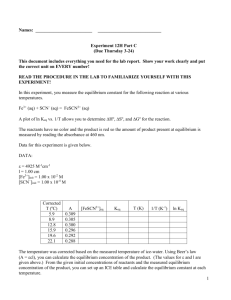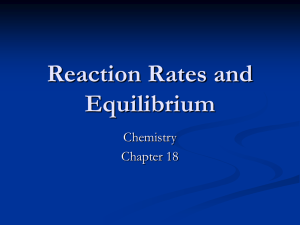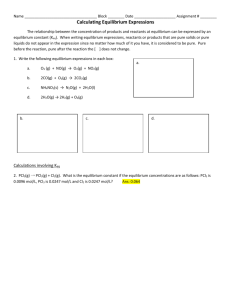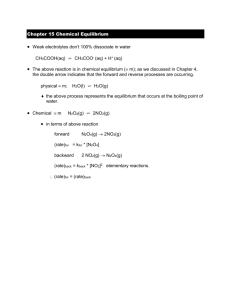Equilibrium Wksht #1
advertisement
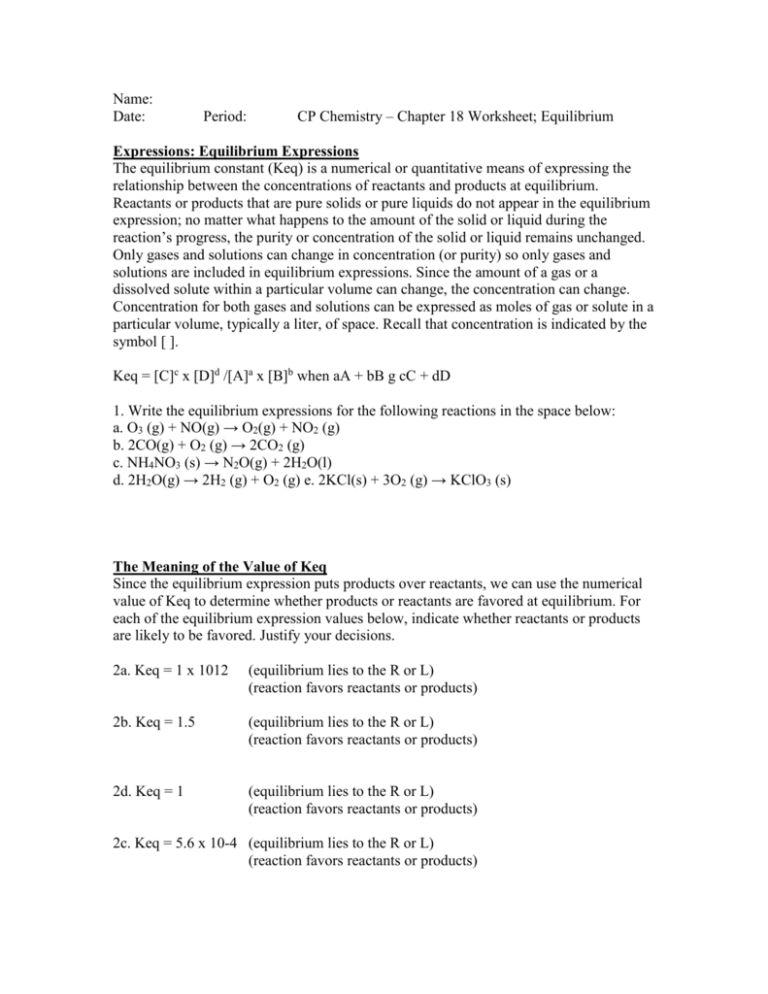
Name: Date: Period: CP Chemistry – Chapter 18 Worksheet; Equilibrium Expressions: Equilibrium Expressions The equilibrium constant (Keq) is a numerical or quantitative means of expressing the relationship between the concentrations of reactants and products at equilibrium. Reactants or products that are pure solids or pure liquids do not appear in the equilibrium expression; no matter what happens to the amount of the solid or liquid during the reaction’s progress, the purity or concentration of the solid or liquid remains unchanged. Only gases and solutions can change in concentration (or purity) so only gases and solutions are included in equilibrium expressions. Since the amount of a gas or a dissolved solute within a particular volume can change, the concentration can change. Concentration for both gases and solutions can be expressed as moles of gas or solute in a particular volume, typically a liter, of space. Recall that concentration is indicated by the symbol [ ]. Keq = [C]c x [D]d /[A]a x [B]b when aA + bB g cC + dD 1. Write the equilibrium expressions for the following reactions in the space below: a. O3 (g) + NO(g) → O2(g) + NO2 (g) b. 2CO(g) + O2 (g) → 2CO2 (g) c. NH4NO3 (s) → N2O(g) + 2H2O(l) d. 2H2O(g) → 2H2 (g) + O2 (g) e. 2KCl(s) + 3O2 (g) → KClO3 (s) The Meaning of the Value of Keq Since the equilibrium expression puts products over reactants, we can use the numerical value of Keq to determine whether products or reactants are favored at equilibrium. For each of the equilibrium expression values below, indicate whether reactants or products are likely to be favored. Justify your decisions. 2a. Keq = 1 x 1012 (equilibrium lies to the R or L) (reaction favors reactants or products) 2b. Keq = 1.5 (equilibrium lies to the R or L) (reaction favors reactants or products) 2d. Keq = 1 (equilibrium lies to the R or L) (reaction favors reactants or products) 2c. Keq = 5.6 x 10-4 (equilibrium lies to the R or L) (reaction favors reactants or products) Calculations Involving Keq The concentrations of the gases involved in the reversible reactions at equilibrium are known as the equilibrium concentrations. Since Keq represents the system at equilibrium, only these concentrations can be used in the equilibrium expressions. 3. What is the equilibrium constant, Keq, if the equilibrium concentrations are as follows: PCl5 is 0.0096 M, PCl3 is 0.0247 M and Cl2 is 0.0247 M? PCl5(g) → PCl3 (g) + Cl2(g). Write the equilibrium expression and solve. 4. At a given temperature, the Keq = 1.40 x 10-2 for the rxn 2HI(g) → H2 (g) + I2 (g). If the concentrations of both H2 and I2 at equilibrium are 2.00 x 10-4M, find the concentration of HI. (Write the equilibrium expression and solve.) 5. Acetic acid dissociates in water. If Keq = 1.80 x 10-5 and the equilibrium concentrations of acetic acid is 0.09986M, what is the concentration of H+(aq) and C2H3O2 - (aq)? HC2H3O2(aq) → H+(aq) + C2H3O2 - (aq) (Write the equilibrium expression and solve.) 6. Hydrogen sulfide gas decomposes into its elements at 1400 oC. One liter of this gas mixture contains 0.18 mol of hydrogen sulfide, 0.014 mol of hydrogen gas and 0.035 mol of sulfur. 2 H2S(g) 2 H2 (g) + S2 (g) a. Calculate the equilibrium constant, Keq, for this reaction. b. Are products or reactants favored? How do you know? 7. How would the equilibrium position for the equation in problem 6 be affected by each of the following stresses? Explain your answers. a. an addition of hydrogen to the reaction vessel? b. a decrease in pressure?

